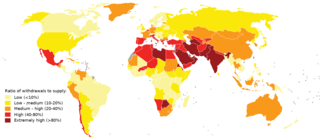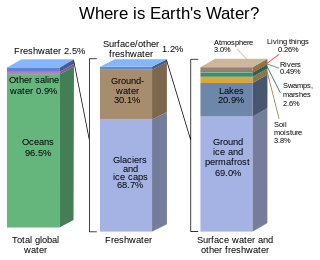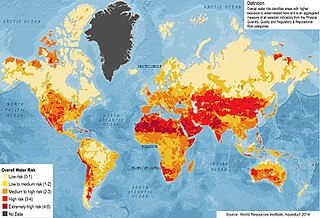
Water reclamation is the process of converting municipal wastewater (sewage) or industrial wastewater into water that can be reused for a variety of purposes. Types of reuse include: urban reuse, agricultural reuse (irrigation), environmental reuse, industrial reuse, planned potable reuse, de facto wastewater reuse. For example, reuse may include irrigation of gardens and agricultural fields or replenishing surface water and groundwater. Reused water may also be directed toward fulfilling certain needs in residences, businesses, and industry, and could even be treated to reach drinking water standards. Treated municipal wastewater reuse for irrigation is a long-established practice, especially in arid countries. Reusing wastewater as part of sustainable water management allows water to remain as an alternative water source for human activities. This can reduce scarcity and alleviate pressures on groundwater and other natural water bodies.
From 1947 to 2017, the Indian economy was premised on the concept of planning. This was carried through the Five-Year Plans, developed, executed, and monitored by the Planning Commission (1951-2014) and the NITI Aayog (2015-2017). With the prime minister as the ex-officio chairman, the commission has a nominated deputy chairman, who holds the rank of a cabinet minister. Montek Singh Ahluwalia is the last deputy chairman of the commission. The Twelfth Plan completed its term in March 2017. Prior to the Fourth Plan, the allocation of state resources was based on schematic patterns rather than a transparent and objective mechanism, which led to the adoption for the Gadgil formula in 1969. Revised versions of the formula have been used since then to determine the allocation of central assistance for state plans. The new government led by Narendra Modi, elected in 2014, has announced the dissolution of the Planning Commission, and its replacement by a think tank called the NITI Aayog.

The International Water Management Institute (IWMI) is a non-profit international water management research organisation under the CGIAR with its headquarters in Colombo, Sri Lanka, and offices across Africa and Asia. Research at the Institute focuses on improving how water and land resources are managed, with the aim of underpinning food security and reducing poverty while safeguarding the environment.
Water resource management is the activity of planning, developing, distributing and managing the optimum use of water resources. It is an aspect of water cycle management.
Environmental issues in Tajikistan, include concentrations of agricultural chemicals and salts in the soil and groundwater, poor management of water resources, and soil erosion. Additionally, because of inadequate sanitation facilities, untreated industrial waste and sewage combine with agricultural runoff to cause water pollution in the Aral Sea Basin. Soviet-Era mining operations in Tajikistan extracted and processed uranium, gold, antimony, tungsten, mercury, and molybdenum, each of which is known to leave toxic waste that also threatens water quality. Pockets of high air pollution caused by industry and motor vehicles have resulted in Tajikistan ranking 133rd in the world in greenhouse gas emissions. Air pollution is a particular problem during times of the year when atmospheric conditions hold industrial and vehicle emissions close to the surface in urban areas. In summer, dust and sand from the deserts of Uzbekistan and Turkmenistan cause air pollution across the entire southwestern lowland region.

Water scarcity is the lack of fresh water resources to meet the standard water demand. Humanity is facing a water crisis, due to unequal distribution resulting in some very wet and some very dry geographic locations, plus a sharp rise in global freshwater demand in recent decades. Water scarcity can also be caused by droughts, lack of rainfall, or pollution. This was listed in 2019 by the World Economic Forum as one of the largest global risks in terms of potential impact over the next decade. It is manifested by partial or no satisfaction of expressed demand, economic competition for water quantity or quality, disputes between users, irreversible depletion of groundwater, and negative impacts on the environment. Two-thirds of the global population live under conditions of severe water scarcity at least 1 month of the year. Half a billion people in the world face severe water scarcity all year round. Half of the world's largest cities experience water scarcity.

Water resources are natural resources of water that are potentially useful as a source of water supply. 97% of the water on the Earth is salt water and only three percent is fresh water; slightly over two thirds of this is frozen in glaciers and polar ice caps. The remaining unfrozen freshwater is found mainly as groundwater, with only a small fraction present above ground or in the air. Natural sources of fresh water include surface water, under river flow, groundwater and frozen water. Artificial sources of fresh water can include treated wastewater and desalinated seawater.

Farm water, also known as agricultural water, is water committed for use in the production of food and fibre and collecting for further resources. In the US, some 80% of the fresh water withdrawn from rivers and groundwater is used to produce food and other agricultural products. Farm water may include water used in the irrigation of crops or the watering of livestock.
WEAP is a Windows-based decision support system for integrated water resources management and policy analysis. WEAP is a model-building tool, used to create simulations of water demand, supply, runoff, evapotranspiration, infiltration, crop irrigation requirements, instream flow requirements, ecosystem services, groundwater and surface storage, reservoir operations, and pollution generation, treatment, discharge and instream water quality, all under scenarios of varying policy, hydrology, climate, land use, technology and socio-economic factors. WEAP can dynamically link to the USGS MODFLOW groundwater flow model and the US EPA QUAL2K surface water quality model.

Water security has been defined as "the reliable availability of an acceptable quantity and quality of water for health, livelihoods and production, coupled with an acceptable level of water-related risks". It is realised to the degree that water scarcity is non-existent, or has been decreased or eliminated, and to the degree that floods and contamination of freshwater supplies are non-threatening. Water security is considered to be a necessity of sustainable development for its importance in the quality of life of the people in a region. Sustainable development would result in lowered poverty and increased living standards for those most susceptible to the impacts of insecure water resources in the region, especially women and children. By clearly defining the responsibilities and control over water management for high usage sectors in terms of finance, planning, agriculture, energy, industry, and health, development may progress to the point of sustainable living for all. The areas of the world that are most likely to have water insecurity are places with low rainfall, places with rapid population growth in a freshwater scarce area, and areas with international competition over a water source. In regions with water security issues and some water scarcity, changes in the local and global environment may soon lead to more intense regulation of water. Already in countries with high water usage, such as the United States and China, these regulations are prominent and grow in number still. International and intranational water conflicts have long been mediated by regulations and treaties, but instances involving worsening situations show some dire outlooks.
Rural poverty refers to poverty in rural areas, including factors of rural society, rural economy, and political systems that give rise to the poverty found there. Rural poverty is often discussed in conjunction with spatial inequality, which in this context refers to the inequality between urban and rural areas. Both rural poverty and spatial inequality are global phenomena, but like poverty in general, there are higher rates of rural poverty in developing countries than in developed countries. Eradicating rural poverty through effective policies and economic growth remains a challenge for the international community.
Physical water scarcity can often occur when and where there is not enough water to meet both human demands and those of ecosystems to function effectively. Arid regions can constantly suffer from physical water scarcity. It also occurs where water seems abundant but resources are over-committed. This can happen where there is overdevelopment of hydraulic infrastructure, often for irrigation or energy generation. Symptoms of physical water scarcity are severe environmental degradation, declining groundwater and water allocations that favour some groups over others.
Nigeria had one of the world's highest economic growth rates, averaging 7.4% according to the Nigeria economic report that was released in July 2019 by the World Bank. Following the oil price collapse in 2014–2016, combined with negative production shocks, the gross domestic product (GDP) growth rate dropped to 2.7% in 2015. In 2016 during its first recession in 25 years, the economy contracted by 1.6%. Nationally, 43 percent of Nigerians live below the poverty line, while another 25 percent are vulnerable. For a country with massive wealth and a huge population to support commerce, a well-developed economy, and plenty of natural resources such as oil, the level of poverty remains unacceptable. However, poverty may have been overestimated due to the lack of information on the extremely huge informal sector of the economy, estimated at around 60% more, of the current GDP figures. As of 2018, Population growth rate is higher than economic growth rate, leading to a slow rise in poverty. According to a 2018 report by the World Bank, almost half the population is living below the international poverty line, and unemployment peaked at 23.1%.

Water scarcity in Africa is predicted to reach dangerously high levels by 2025. It is estimated that about two-third of the world's population may suffer from fresh water shortage by 2025. The main causes of water scarcity in Africa are physical and economic scarcity, rapid population growth, and climate change. Water scarcity is the lack of fresh water resources to meet the standard water demand. Although Sub-Saharan Africa has a plentiful supply of rainwater, it is seasonal and unevenly distributed, leading to frequent floods and droughts. Additionally, prevalent economic development and poverty issues, compounded with rapid population growth and rural-urban migration have rendered Sub-Saharan Africa as the world's poorest and least developed region.

Water resource policy, sometimes called water resource management or water management, encompasses the policy-making processes and legislation that affect the collection, preparation, use, disposal, and protection of water resources. Water is necessary for all forms of life as well as industries on which humans are reliant, like technology development and agriculture. This global need for clean water access necessitates water resource policy to determine the means of supplying and protecting water resources. Water resource policy varies by region and is dependent on water availability or scarcity, the condition of aquatic systems, and regional needs for water. Since water basins do not align with national borders, water resource policy is also determined by international agreements, also known as hydropolitics. Water quality protection also falls under the umbrella of water resource policy; laws protecting the chemistry, biology, and ecology of aquatic systems by reducing and eliminating pollution, regulating its usage, and improving the quality are considered water resource policy. When developing water resource policies, many different stakeholders, environmental variables, and considerations have to be taken to ensure the health of people and ecosystems are maintained or improved. Finally, ocean zoning, coastal, and environmental resource management are also encompassed by water resource management, like in the instance of offshore wind land leasing.

Climate change in Bangladesh is a critical issue as the country is one of the most vulnerable to the effects of climate change. In the 2020 edition of Germanwatch's Climate Risk Index, it ranked seventh in the list of countries most affected by climate calamities during the period 1999–2018. Bangladesh's vulnerability to climate change impacts is due to a combination of geographical factors, such as its flat, low-lying, and delta-exposed topography, and socio-economic factors, including its high population density, levels of poverty, and dependence on agriculture.

Water issues in developing countries include scarcity of drinking-water, poor infrastructure for water access, floods and droughts, and the contamination of rivers and large dams. Over one billion people in developing countries have inadequate access to clean water. Barriers to addressing water problems in developing nations include poverty, climate change, and poor governance.
The water, energy and food security nexus according to the Food And Agriculture Organisation of the United Nations (FAO), means that water security, energy security and food security are very much linked to one another, meaning that the actions in any one particular area often can have effects in one or both of the other areas.

Water in Africa is an important issue encompassing the sources, distribution and economic uses of the water resources on the continent. Overall, Africa has about 9% of the world's fresh water resources and 16% of the world's population. There are about 17 rivers in the African continent.Among these rivers are the Congo, Nile, Zambezi, Niger and Lake Victoria, considered the world’s second largest lake.

Fresh water or freshwater is any naturally occurring liquid/solid water containing low concentrations of dissolved salts and other total dissolved solids. Although the term specifically excludes seawater and brackish water, it does include non-salty mineral-rich waters such as chalybeate springs. Fresh water may encompass frozen and meltwater in ice sheets, ice caps, glaciers, snowfields and icebergs, natural precipitations such as rainfall, snowfall, hail/sleet and graupel, and surface runoffs that form inland bodies of water such as wetlands, ponds, lakes, rivers, streams, as well as groundwater contained in aquifers, subterranean rivers and lakes.











